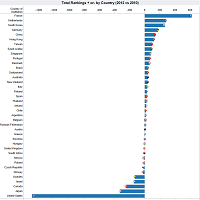

After reading an article from HESA where the author explains (referring to Times Higher Education’s annual Reputation Rankings) that “only the position of the top 6 or so is genuinely secure. Below about tenth position, everyone else is packed so closely together that changes in rank order are basically guaranteed”, we wanted to see how much movement there was at the bottom of the rankings. How did we do this?
We took 7 world university rankings that had some historical data (see note). We selected the years 2010 and 2012 and subtracted the average of the 7 rankings for the 2010 rank from the average of the 2012 rank. For example, Yale University has the overall average rank of “12” in 2010 and “14” in 2012. The equation would be 12 -14 = -2.
If you click on one of the countries, the bottom graph will only include the universities from that specific country.
A few observations:
Top and Bottom countries by total + or – ranks
- European universities have generally improved their rankings
- Sweden’s quality education system is looking fragile from this angle
- North American universities, as a group, look as if they have passed their peek
- Could the massive cuts in US higher education explain the slumping in the rankings?
- Most countries, 28 out 39, remain in the + or – 100 range. The others are as follows:
| COUNTRIES | Total Difference in rank |
| France | +610 |
| Netherlands | +278 |
| Korea | +261 |
| Germany | +175 |
| China | +139 |
| Hong Kong | +123 |
| Sweden | -129 |
| Israel | -139 |
| Canada | -248 |
| Japan | -323 |
| United States | -1469 |
Top 10 University biggest increase
The biggest increases are not seen in all newer institutions. They are a mixture of new and old universities: University of Strasbourg (1538), Joseph Fourier University (1811), Wageningen University and Research Centre (1918), King Saud University (1957), Sungkyunkwan University (1393), Nanyang Technological University (1991), Radboud University Nijmegen (1923), Korea University (1905), Hong Kong Polytechnic University (1937) and Cardiff University (1883)
| Difference in rank | UNIVERSITY | COUNTRY |
| +222 | University of Strasbourg | France |
| +133 | Joseph Fourier University | France |
| +116 | Wageningen University and Research Centre | Netherlands |
| +92 | King Saud University | Saudi Arabia |
| +88 | Sungkyunkwan University | Korea |
| +73 | Nanyang Technological University | Singapore |
| +66 | Radboud University Nijmegen | Netherlands |
| +66 | Korea University | Korea |
| +63 | Hong Kong Polytechnic University | Hong Kong |
| +61 | Cardiff University | United Kingdom |
Bottom 10 Universities
50% of the bottom 10 are from the USA. 80% the 5 USA universities are publicly funded
| Difference in rank | University | Type | Country |
| -51 | Keio University | Private | Japan |
| -54 | University of Dundee | Public | United Kingdom |
| -57 | University of Cincinnati | Public | United States |
| -61 | Swedish University of Agricultural Sciences | Public | Sweden |
| -62 | Dartmouth College | Private | United States |
| -62 | Rensselaer Polytechnic Institute | Private | United States |
| -90 | Weizmann Institute of Science | Public | Israel |
| -93 | University of California, San Francisco | Public | United States |
| -106 | University of Alabama at Birmingham | Public | United States |
| -120 | Karolinska Institutet | Private | Sweden |
Note: A total of 398 universities had 5 or more rankings in 2010 and 2012.

